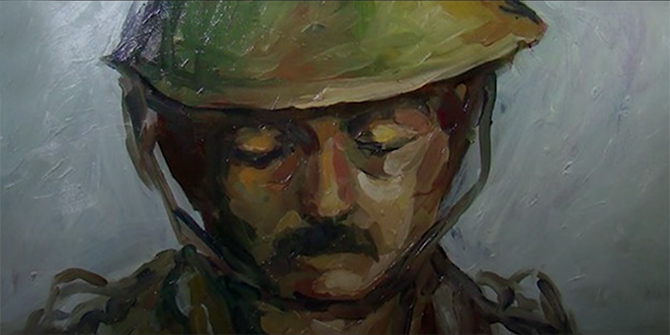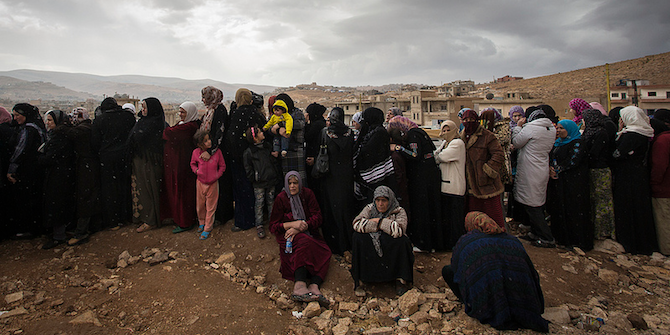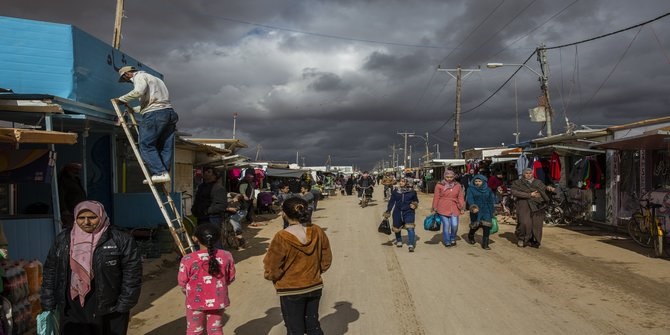by Rochelle Davis
#LSERefugees
This paper was presented at a workshop on ‘The Long-term Challenges of Forced Migration: Local and Regional Perspectives from Lebanon, Jordan and Iraq’ organised by the LSE Middle East Centre in June 2016. It was published as part of a collected papers volume available in English and Arabic.

Introduction
Any thoughtful examination of the last five years of fighting in Syria raises questions about how we think about gender, and particularly men, during conflict. The media and reports by non-governmental associations repeatedly report that 75 percent of Syrian refugees are women and children. What they fail to do, however, is examine the statistics. Just over 50 percent of the refugees are children, and thus slightly less than 50 percent are adults. The statistics also show, with variation among host countries, that about half the adults are women and half are men; thus indeed, some 75 percent of the refugees are women and children. But equally, 75 percent of the refugees are men and children. Yet that statistic is never cited as significant, nor is it used to stir empathy for the refugees or create policy and programming.
Why are we so unwilling to describe men as vulnerable or in need of protection? It is true that the vast majority of those engaged in the fighting are men – whether on the side of the Syrian regime or among the myriad of armed opposition groups. But what about the millions of men who have chosen not to fight? Understanding the choices made by those men who remove themselves – and their families – from conflict allows a window into the lives of a much larger portion of Syrians. These people tell a very different story about the conflict in Syria, and they too should be represented, their experiences respected, and assistance programmes developed for them. In cases of conflict, as is ongoing in Syria, a more holistic approach to understanding gendered vulnerabilities will allow us to develop better programming for men, which will only improve the abilities of women and children, indeed all Syrians, to weather war, displacement, unemployment, exploitative circumstances, illness and trauma.
Understanding why men choose to not fight in the conflict also provokes us to think about how host governments, the UN system and the international community might better deal with non-combatant men. This is not to suggest that men should be prioritised over women, children or any of the other categories that address those needing assistance. But it is to suggest that better consideration of the plight of men of military age would allow humanitarian actors to play a critical role in removing people from combat – both potential or real combatants and victims. Given the roles that international actors are playing in fueling and/or observing the fighting and the inability or unwillingness of the international community to stop the conflict, helping to provide solutions for individuals who choose not to fight is a small but important step that the humanitarian aid community could take.
According to international law, non-combatant men are civilians, just as are the women, children and elderly who have fled the fighting. And yet, in the last five years, we have seen host governments prevent them from crossing into their countries legally out of fear that this male demographic brings the conflict with them and endanger their own citizens. Similarly, post-2014, migration flows have seen both a disproportionate number of men entering via Italy and Greece and expressions of concern about what this demographic will mean for Europe.
In short, the last five years have seen men of military-age considered by virtue of their gender as potential combatants and/or a source of danger and instability. This demographic characterisation means that even if a man does not have weapons and is not engaged in fighting, he is assumed, at the very least, to be willing or able to fight. He is therefore seen either as an asset or a threat – to the regime, the opposition movements or the governments of host countries. His demographic characteristics trump his ability to define himself as a civilian by his actions and beliefs …continue reading
Download the paper in English | Download the paper in Arabic
Rochelle Davis is an Associate Professor of Cultural Anthropology in the Center for Contemporary Arab Studies at Georgetown University’s Edmund A. Walsh School of Foreign Service. She tweets at @RochelleADavis.
Other papers in the series
- Syrian Refugees in Lebanon: A Turning Point?
Mireille Girard
- Syrian Refugees and the Kurdistan Region of Iraq
Hayder Mustafa Saaid
- Iraqi and Syrian Refugees in Jordan Adjusting to Displacement: Comparing their Expectations towards UNHCR and their Capacities to use their Educational Assets
Géraldine Chatelard
- The Informal Adaptive Mechanisms among Syrian Refugees and Marginalised Host Communities in Lebanon
Nasser Yassin & Jana Chammaa
- Relations Between UNHCR and Arab Governments: Memoranda of Understanding in Lebanon and Jordan
Ghida Frangieh
- The Syrian Humanitarian Disaster: Understanding Perceptions and Aspirations in Jordan, Lebanon and Turkey
Dawn Chatty
- The Syrian Refugee Crisis: A Global and Regional Perspective
François Reybet-Degat






